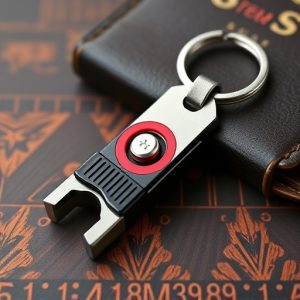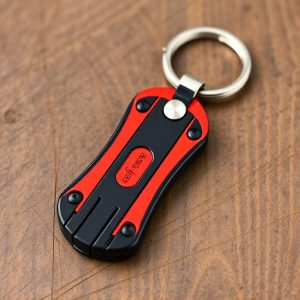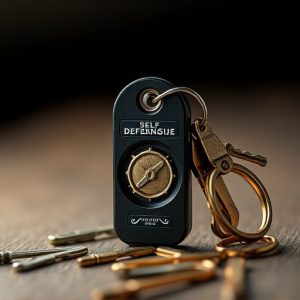Hidden Self-Defense Keychains: Legalities, Safety, and Use Cases Unlocked
The legal status of hidden self-defense keychain tools varies globally, with regulations dictating a…….
The legal status of hidden self-defense keychain tools varies globally, with regulations dictating age restrictions, permit types, and public safety considerations. These tools, including folding knives or pepper spray dispensers, fall under definitions like "concealed weapons" or "personal protection devices." Local laws define legal self-defense options, and navigating these is crucial to avoid legal repercussions. Manufacturers and importers must adhere to global standards for material composition, mechanism design, and packaging labeling to ensure product safety and legality. Stricter safety standards, such as those from the U.S. CPSC, mandate rigorous testing to prevent user harm. Following these regulations empowers individuals to protect themselves while safeguarding public safety.
“Ensuring keychain safety and legality of hidden self-defense tools is paramount for personal security. This comprehensive guide delves into the intricate web of legal definitions, jurisdiction-specific regulations, and manufacturing standards surrounding these compact defense devices. From understanding local laws to exploring permitted use cases, we navigate the landscape of consumer protection. Learn about the regulatory requirements for importing and producing hidden self-defense keychain tools, empowering you with knowledge to make informed choices.”
- Understanding Legal Definitions of Hidden Self-Defense Keychain Tools
- Jurisdiction and Local Laws: What You Need to Know
- Permitted Use Cases for Personal Defense Devices
- Regulatory Requirements for Manufacturing and Importing
- Consumer Protection and Safety Standards for Keychain Self-Defense Tools
Understanding Legal Definitions of Hidden Self-Defense Keychain Tools
In many jurisdictions, the legal landscape surrounding hidden self-defense keychain tools is nuanced and complex. These devices, designed to provide personal protection in a discrete manner, fall under unique legal categories that vary from place to place. Understanding the specific definitions and regulations is crucial for anyone considering carrying such a tool. The term “hidden self-defense keychain tool” often refers to devices attached to keychains that can serve as weapons or tools for self-defense, typically folding knives or pepper spray dispensers.
Legal definitions play a pivotal role in dictating the legality of these tools. Some regions classify them as concealed weapons, subject to strict regulations and permits. Others might categorize them under personal protection devices, allowing their possession without a license. When assessing keychain safety device legal requirements, it’s essential to research local and state laws, considering factors like minimum age restrictions, permit types, and public safety considerations. Staying informed ensures compliance and promotes peace of mind while carrying a hidden self-defense keychain tool.
Jurisdiction and Local Laws: What You Need to Know
When considering the legal aspects of carrying a hidden self-defense keychain tool, understanding jurisdiction and local laws is paramount. These regulations can vary significantly from one region to another, and what’s permitted in one place might be restricted or illegal in another. It’s crucial to research and stay informed about the specific rules in your area before purchasing or using such a device. Many countries have broad laws that protect personal safety, which could include concealed carry options for self-defense tools, but these are often subject to certain conditions and restrictions.
Local laws may define what constitutes a legal self-defense tool, its size, design, and the circumstances under which it can be carried. Some jurisdictions might require permits or licenses for certain types of hidden keychain tools, while others might have specific ban lists that prohibit similar devices. Staying compliant ensures not only your safety but also avoids potential legal consequences.
Permitted Use Cases for Personal Defense Devices
Personal defense devices, especially those in compact forms like hidden keychain tools, have evolved to cater to various needs for self-protection. These tools are designed to provide individuals with a sense of security and the ability to defend themselves in unexpected situations. Legally, the permitted use cases for such devices vary across jurisdictions but often include scenarios where an individual feels threatened or is confronted with physical harm.
In many regions, hidden self-defense keychain tools can be used as a last resort when other means of escaping or de-escalating a situation have failed. They are not intended to provoke or initiate conflict but rather to empower individuals to protect themselves and escape potentially dangerous encounters. This legal framework ensures that the right to self-defense is balanced with public safety, allowing citizens to take proactive measures while adhering to specific guidelines.
Regulatory Requirements for Manufacturing and Importing
In the realm of personal safety, hidden self-defense keychain tools have gained prominence as convenient and discrete means of protection. However, for manufacturers and importers, navigating regulatory requirements is an indispensable step in bringing these innovative products to market. Regulatory bodies worldwide mandate specific standards to ensure product safety, quality, and legality, especially for items classified as potential weapons. These guidelines are designed to protect consumers and maintain public safety without unduly hindering the development of useful self-defense tools.
Compliance involves adhering to regulations such as material composition, mechanism design, and packaging labeling. For instance, many countries require hidden keychain tools to be made from non-hazardous materials and have safe actuation mechanisms. Importers must also consider customs regulations, which may include permits, documentation, and restrictions on certain types of self-defense devices. Staying informed about these requirements is crucial for a seamless distribution process and ensuring that the hidden self-defense keychain tools meet legal standards while providing users with effective personal safety solutions.
Consumer Protection and Safety Standards for Keychain Self-Defense Tools
When considering consumer protection and safety standards for hidden self-defense keychain tools, it’s crucial to understand regulatory frameworks designed to safeguard users. Many regions have strict guidelines governing personal defense devices, including requirements for testing, materials, and functionality. These standards ensure that products are safe and effective when used responsibly. For instance, in the United States, the Consumer Product Safety Commission (CPSC) sets rules for certain types of self-defense tools, focusing on factors like impact strength and sharpness to prevent injury during use.
In light of increasing popularity of hidden self-defense keychain tools, market regulators are paying closer attention. Manufacturers must adhere to specific safety protocols and often obtain certifications from independent labs to prove compliance. This not only ensures product reliability but also helps clarify legal boundaries for what constitutes an acceptable self-defense device under consumer protection laws. Using approved materials and adhering to safety standards is essential for both manufacturers and users to avoid legal repercussions and ensure the intended purpose of these handy, yet potentially dangerous, tools—personal safety—is served without negative consequences.
When it comes to the legal landscape surrounding hidden self-defense keychain tools, understanding both local and federal regulations is paramount. These devices, while offering personal safety, must adhere to strict manufacturing and importing standards to ensure consumer protection. Knowing your rights and responsibilities under various jurisdictions allows for informed decision-making when considering such a tool. Always stay up-to-date with the latest legal definitions and requirements to ensure compliance—your safety and peace of mind depend on it.


